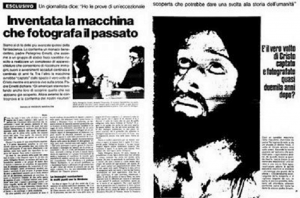It had to be true. After all, it was there in black and white in La Domenica del Corriere (“Courier Sunday”), a long-established weekly news magazine: “Invented: a machine that photographs the past.” Not only was there a diagram of the machine but a photograph of an ancient event — the face of Jesus Christ during his crucifixion. Moreover, the story came from an Italian Benedictine monk who said he was part of a Vatican-funded team that invented the “Chronovisor.”
Father Pellegrino Ernetti was a noted musicologist who also studied physics. Ernetti worked on an audio project involving Gregorian chants at the Catholic University of Milan. Listening to one of the tapes in September 1952, the school’s founder, Father Agostino Gemelli, was convinced he heard his dead father’s voice. Ernetti wondered if sound somehow continued to exist in some way. Gemelli was president of the Pontifical Academy of Sciences and obtained funding for a team led by Ernetti to explore the question.
Ernetti said a team of 12 people worked for years on the project. French priest Francois Brune, a friend of Ernetti’s, would later report that Ernetti only identified two: Nobel Laureate Enrico Fermi and rocket scientist Wernher von Braun. In his May 2, 1972, interview with La Domenica del Corriere, Ernetti said the group discovered that sound and light disintegrate into different energy forms. Using a series of antennas made of three mysterious metals, the Chronovisor reconstructed residual electromagnetic radiation left over by numerous processes. A sensor could select a specific location, date, and even a particular person, and the reconstruction appeared on a cathode ray tube.
The device was more television than a time machine. It didn’t take someone physically into the past, only allowed past events to be viewed and recorded. Hence, the name Chronovisor. Ernetti told the magazine that the scientific team viewed the crucifixion of Christ and other events, but he believed the device was dangerous because it could pick up thoughts. Notably, Ernetti did not provide a photo of Christ’s face. The Milan-based magazine said it received it from an anonymous man.

Article in La Domenica del Corriere
In his 2002 book, Le Nouveau Mystere du Vatican (“The New Mystery of the Vatican”), Brune said Ernetti told him they recorded Christ from the Last Supper to his death. According to Brune, these weren’t the first or only events the team viewed. They observed speeches by Cicero, Mussolini, and Napoleon, looked at a 2nd-century Roman market, and saw a 169 BCE performance of the play Thyestes by Roman poet Quintus Ennius. Only fragments of the play still existed, so Ernetti transcribed the entire performance as proof of the Chronovisor’s existence.
Ernetti told Brune they disassembled the machine after the experimental stage because of fear it could reveal anything that happened in the past, including state secrets. The claimed destruction led to conjecture that the Chronovisor still exists, stashed away in the Vatican Secret Archive. Yet, there seem to be more grounds to doubt the machine ever existed.
Several months after the story in La Domenica del Corriere, another Italian magazine received a photograph of the face of Christ on a woodcarving in a church in a small Umbrian village. Aside from being reversed, the image was virtually identical to the photo in La Domenica del Corriere. A Spanish sculptor made the woodcarving in 1931 based on a nun’s vision. According to Brune, Ernetti said it resembled the Chronovisor photo because the nun saw the actual crucifixion, just as they had.
Ernetti’s other “proof” also seems problematic. Katherine Eldred, a doctor in classics, was asked to study and translate Ernetti’s Thyestes for the English edition of Austrian Peter Krassa’s 1997 book about Ernetti. Eldred noted that Ernetti’s transcription was only a tenth as long would be expected, and a number of the words in it weren’t part of the Latin language for another 250 years. She also said that the wording suggested limited Latin skills, which one wouldn’t expect of someone who wrote in Latin.
Krassa also published a letter reportedly from an unidentified “distant relative” of Ernetti. It claimed that on his deathbed in 1994, the monk confessed that the Christ photo and Thyestes manuscript were fake. Ernetti also supposedly said Fermi had nothing to do with the Chronovisor, although, notably, he insisted the machine was real. Brune, whose book awaits an English translation, says any such confession was false and forced by church authorities.
Despite no hard evidence of its existence, any time machine in the Vatican Secret Archive is exceptional fodder for all kinds of tales. But why would an educated and respected monk invent and stand by such an outlandish story for decades? A definitive answer may require a machine that can see past events and read the participants’ thoughts.
All investigations of Time, however sophisticated or abstract, have at their true base the human fear of mortality
Thomas Pynchon, Against the Day
(Originally posted at History of Yesterday)







